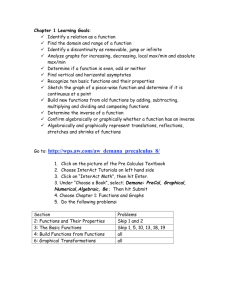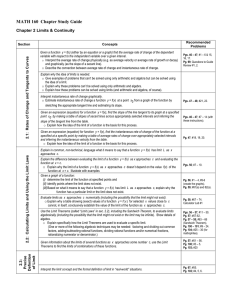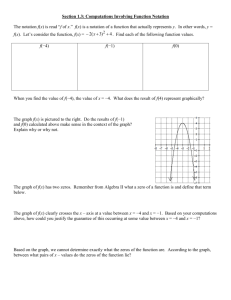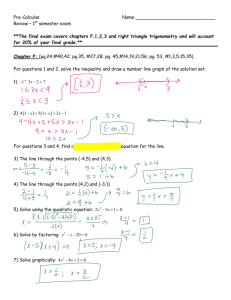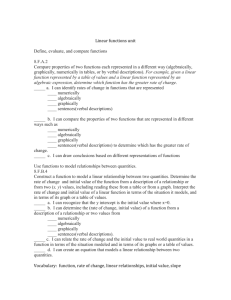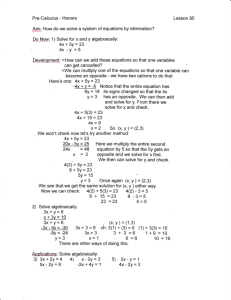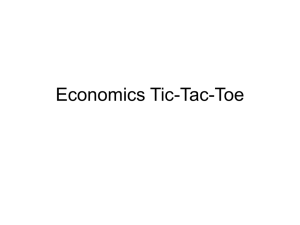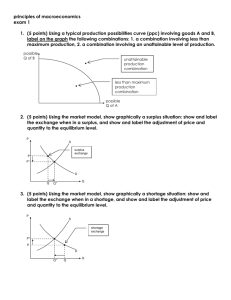Study Guide
advertisement
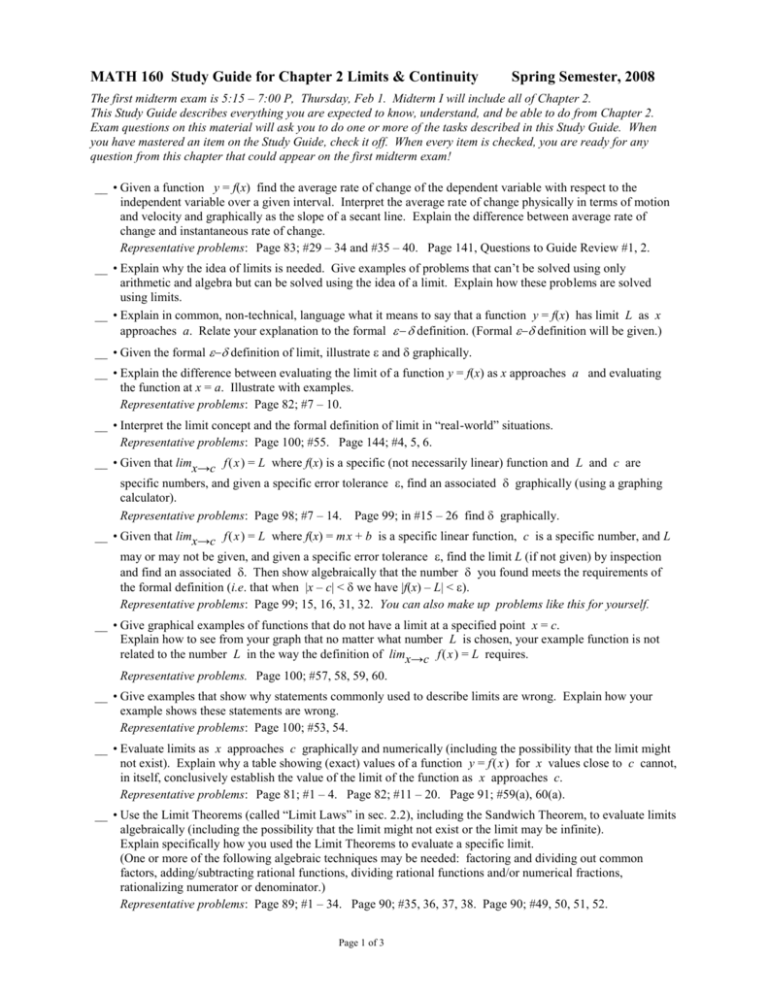
MATH 160 Study Guide for Chapter 2 Limits & Continuity Spring Semester, 2008 The first midterm exam is 5:15 – 7:00 P, Thursday, Feb 1. Midterm I will include all of Chapter 2. This Study Guide describes everything you are expected to know, understand, and be able to do from Chapter 2. Exam questions on this material will ask you to do one or more of the tasks described in this Study Guide. When you have mastered an item on the Study Guide, check it off. When every item is checked, you are ready for any question from this chapter that could appear on the first midterm exam! __ • Given a function y = f(x) find the average rate of change of the dependent variable with respect to the independent variable over a given interval. Interpret the average rate of change physically in terms of motion and velocity and graphically as the slope of a secant line. Explain the difference between average rate of change and instantaneous rate of change. Representative problems: Page 83; #29 – 34 and #35 – 40. Page 141, Questions to Guide Review #1, 2. __ • Explain why the idea of limits is needed. Give examples of problems that can’t be solved using only arithmetic and algebra but can be solved using the idea of a limit. Explain how these problems are solved using limits. __ • Explain in common, non-technical, language what it means to say that a function y = f(x) has limit L as x approaches a. Relate your explanation to the formal definition. (Formal definition will be given.) __ • Given the formal definition of limit, illustrate and graphically. __ • Explain the difference between evaluating the limit of a function y = f(x) as x approaches a and evaluating the function at x = a. Illustrate with examples. Representative problems: Page 82; #7 – 10. __ • Interpret the limit concept and the formal definition of limit in “real-world” situations. Representative problems: Page 100; #55. Page 144; #4, 5, 6. __ • Given that limx→c f( x) = L where f(x) is a specific (not necessarily linear) function and L and c are specific numbers, and given a specific error tolerance , find an associated graphically (using a graphing calculator). Representative problems: Page 98; #7 – 14. Page 99; in #15 – 26 find graphically. __ • Given that limx→c f( x) = L where f(x) = mx + b is a specific linear function, c is a specific number, and L may or may not be given, and given a specific error tolerance , find the limit L (if not given) by inspection and find an associated Then show algebraically that the number you found meets the requirements of the formal definition (i.e. that when |x – c| < we have |f(x) – L| < ). Representative problems: Page 99; 15, 16, 31, 32. You can also make up problems like this for yourself. __ • Give graphical examples of functions that do not have a limit at a specified point x = c. Explain how to see from your graph that no matter what number L is chosen, your example function is not related to the number L in the way the definition of limx→c f( x) = L requires. Representative problems. Page 100; #57, 58, 59, 60. __ • Give examples that show why statements commonly used to describe limits are wrong. Explain how your example shows these statements are wrong. Representative problems: Page 100; #53, 54. __ • Evaluate limits as x approaches c graphically and numerically (including the possibility that the limit might not exist). Explain why a table showing (exact) values of a function y = f( x) for x values close to c cannot, in itself, conclusively establish the value of the limit of the function as x approaches c. Representative problems: Page 81; #1 – 4. Page 82; #11 – 20. Page 91; #59(a), 60(a). __ • Use the Limit Theorems (called “Limit Laws” in sec. 2.2), including the Sandwich Theorem, to evaluate limits algebraically (including the possibility that the limit might not exist or the limit may be infinite). Explain specifically how you used the Limit Theorems to evaluate a specific limit. (One or more of the following algebraic techniques may be needed: factoring and dividing out common factors, adding/subtracting rational functions, dividing rational functions and/or numerical fractions, rationalizing numerator or denominator.) Representative problems: Page 89; #1 – 34. Page 90; #35, 36, 37, 38. Page 90; #49, 50, 51, 52. Page 1 of 3 MATH 160 Study Guide for Chapter 2 Spring, 2008 __ • Given information about the limits of several functions as x approaches some number c, use the Limit Theorems to find the limits of combinations of these functions. Representative problems: Page 90; #39 – 42. Page 91; #55 – 58. Page 145; #14, 20. __ • Evaluate one-sided limits graphically and algebraically. Explain the connection between one-sided limits and limits (aka two-sided limits). Use information about the one-sided limits to infer the existence or nonexistence of a limit. Representative problems: Pages 111 – 113; #1 – 18. Page 114; #63, 64. __ • Explain common, non-technical, language what it means for a function to have a limit L as x approaches plus or minus infinity. Use a graph to illustrate your explanation. Explain what is meant by a horizontal asymptote of a graph. Explain how limits as x approaches ± ∞ and horizontal asymptotes are related. ___• Explain why you would expect the familiar Limit Theorems for sums, difference, products, and quotients of functions to be true for limits as x approaches infinity or minus infinity. __ • Evaluate limits as x approaches ± ∞ numerically and graphically (including the possibility that the limit might not exist). Explain why a table showing (exact) values of a function y = f( x) for very large x values cannot, in itself, conclusively establish the value of the limit of the function as x approaches ± ∞. Representative problems: Page 113; #37 – 46 (Change instructions to fit this statement.). Page 114; #70. ___• Evaluate the limits of rational functions as x approaches infinity or minus infinity algebraically. Show the details of the algebraic work (as in Examples 8 and 9, page 109). Use a calculator to confirm the results numerically and/or graphically. Explain how to see that the limit of the ratio of two polynomials of the same degree is the ratio of their leading coefficients. Representative problems: Page 113 – 114; #47 – 56. ___• Explain in common, non-technical, language what it means when we say a function has infinity or minus infinity as it limit as x approaches a number a and as x approaches a number a from the left or from the right. Explain the difference between having a limit and having an infinite limit. In particular, explain why it is that a function can at the same time have an infinite limit and not have a limit. ___ Explain what is meant by a vertical asymptote. Explain how infinite limits and vertical asymptotes are related. Use graphs to illustrate your explanations. __ • Explain the connection between one-sided limits and limits (aka two-sided limits), including infinite limits. Use information about the one-sided limits to infer the existence or non-existence of a limit (including infinite limits). Evaluate limits (including one-sided limits) algebraically, including the possibility that the limit might not exist or might be plus or minus infinity. Representative problems: Page 122; #1 - 26. ___• Sketch the graph of a function that has specified vertical and horizontal asymptotes and, perhaps, specified values at certain points. Asymptotes may be given explicitly or have to be inferred from statements about limits. Representative problems: Page 123; #39 – 46. ___• Use algebra to locate points where the graph of a given rational function might have vertical asymptotes. Then evaluate the relevant limits to determine whether the graph actually has vertical asymptotes at these points. Use your calculator to confirm your findings numerically and/or graphically. Representative problems: Page 122; #27 – 38. You can create your own problems like this. Use polynomials of degree no greater than 4. __ • State the mathematical definition of the phrase “a function y = f(x) is continuous at x = c”. Identify points where a function is continuous and where it is not continuous from the graph of the function. Explain in terms of the definition why the function is or is not continuous at the point(s) in you identified. Representative problems: Page 132; #1 – 10. __ • Give graphical examples of functions that (i) are not continuous at a point c but do have a limit as x approaches c; (ii) are not continuous at a point c but are defined at the point x = c; (iii) are not continuous at a point c, but have both a left-hand and a right-hand limit as x approaches c. If it is not possible to give such an example, explain why. Page 2 of 3 MATH 160 Study Guide for Chapter 2 Spring, 2008 __ • Use the facts (theorems) that algebraic combinations and compositions of continuous functions are continuous to explain how to see that a given function is continuous. Then use the fact that the function is continuous to justify evaluating its limit by substitution. Representative problems: Page 133; #11 – 28. __ • Given a function (that may be defined piecewise), use the definition to determine whether the function is continuous at specified points. Explain how your conclusion follows from the definition. If the function has a removable discontinuity at a point x = c, determine what value should be assigned to f(c) so as to make the function be continuous at the point x = c. Representative problems: Page 133; #35 – 40. __ • Explain what the Intermediate Value Property is. Explain how to see graphically that any continuous function whose domain is an interval of real numbers must have the Intermediate Value Property. (In other words, explain the Intermediate Value Theorem graphically.) Use the Intermediate Value Theorem to explain why a given function must take on certain values and why certain equations must have solutions. Representative problems: Pages 133 –134; #45 – 49, 57, 58, 59. Page 145; #19. __ • State the definition of derivative of a function y = f(x) at a specific point x = xo (as a limit). Illustrate and explain each part of the definition graphically (using secant lines, tangent lines, etc.). Explain why the definition requires taking a limit and what the limit means in this setting. __ • Estimate the derivative of a function at a given point from a graph of the function. Representative problems: Page 140; #1 – 4. __ • Find the slope of the tangent to the graph of a given function y = f(x) at a specific point x = xo by using the definition of the slope as the limit of slopes of secant lines. If the relevant limit does not exist, explain what this tells you about the existence or non-existence of a tangent line. If there is a tangent line, write an equation for the tangent line i n p o i n t - slo p e f o rm . Check your work by estimating the slope graphically and comparing your answer (using a calculator). Representative problems. Page 140; #5 – 22. Page 140 – 141; #31 – 44. __ • Given function y = f(x) that relates two physical quantities (e.g. time and position, elevation and atmospheric pressure, radius and volume) use the definition of the instantaneous rate of change as the limit of average rates of change to find the instantaneous rate of change at a specified value for the independent variable. Representative problems. Page 140; #27 – 30. Page 3 of 3
